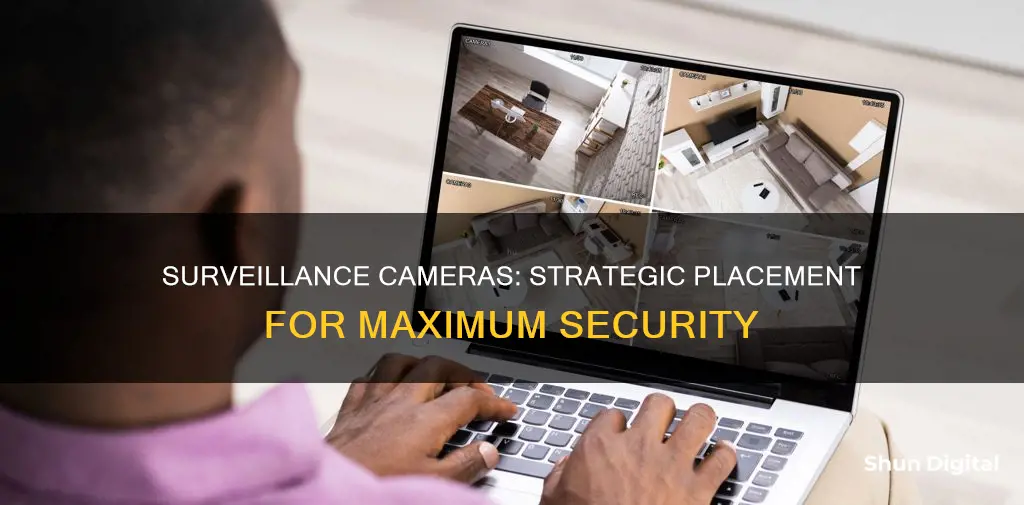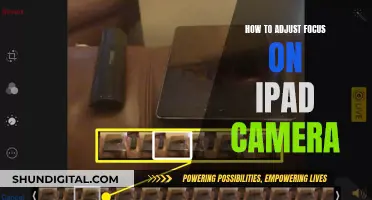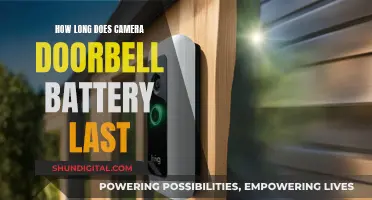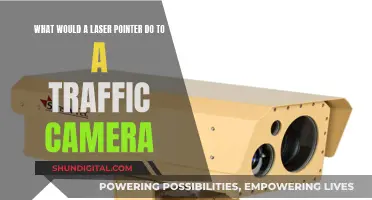
Surveillance cameras are a great way to enhance security and protect your property. When it comes to placing surveillance cameras, there are several key factors to consider. Firstly, identify the areas you want to monitor, such as main entrances, exits, and vulnerable spots like front and back doors, off-street windows, driveways, and common areas. The placement height is crucial, with exterior cameras recommended at a second-story level or at least nine feet above the ground to avoid tampering. Consider the angle of the cameras to capture optimal footage and deter intruders effectively. Additionally, decide whether you want the cameras to be visible or concealed, weighing the benefits of deterrence against the risk of vandalism or theft. It's also important to ensure your cameras are securely installed, with proper mounting and protection from the elements.
| Characteristics | Values |
|---|---|
| Camera Placement | Place cameras where there is an asset to defend or at a choke point towards an asset. |
| Camera Types | Fixed cameras, mechanical PTZs, and panoramic cameras are options, each with different benefits. |
| Camera Views | Ensure cameras are positioned to capture the target effectively, optimising the Field of View (FoV). |
| Height | Install cameras 8-10 feet from the ground to capture detail while being out of reach. |
| Lighting | Avoid pointing cameras at the sun or bright lights, and angle for indirect light to prevent glare and high contrast. |
| Visibility | Decide between visible or hidden cameras; visible cameras deter crime but are also targets for vandalism or theft. |
| Weather Protection | Choose weatherproof cameras and place them in semi-protected areas to shield from the elements. |
| Reflection | Avoid pointing cameras at windows to prevent reflection issues and image degradation. |
| Wi-Fi Signal | Ensure a strong Wi-Fi signal to capture and relay footage without disruption. |
| Power Source | Consider Power over Ethernet (PoE) for wired cameras. |
| Mounting | Securely attach cameras to walls or ceilings, using adhesives or screws, to prevent tampering. |

Front, back, and side doors
Front Door
Around 34% of burglars enter through the front door, making it the most important security camera placement outside your home. Place your camera at second-floor level to avoid a burglar from knocking it out. If your home only has one level, you could enclose your front door security camera in mesh wiring to protect it from tampering. Alternatively, you can replace your existing doorbell with a doorbell camera, some of which can work without Wi-Fi and don't require any subscription.
The best way to place your camera is about 7ft up (no less) and pointing downward at an angle. This is the ideal position to record facial images.
Back and Side Doors
Up to 22% of thieves invade houses through the back door, so you would benefit from using a camera here. This includes side doors as well. Attach a security camera to every door in case of intrusion. Again, try to keep it out of the reach of humans or things they can throw at a camera. If there is a window adjacent to the door, position the camera so that it covers both. If that's a bit awkward, then have one covering the back door and another at the window. Whatever camera system you choose, make sure they are fully weatherproof and can resist all kinds of outdoor conditions.
Garage and Driveway
Garages are a common target for burglars because they're one of the weakest entry points. A camera pointed at your garage and/or driveway keeps a watchful eye on bikes, tools, grills, sports equipment, cars, and everyone that handles them. If your garage is detached, the camera helps you stay connected. If the garage is attached, the extra layer of security monitors another possible entryway into your home.
Fight Camera Tickets: Know Your Rights, California!
You may want to see also

Off-street windows
When installing a camera near off-street windows, it is important to consider the height of the camera. Generally, cameras should be placed at least nine feet above the ground to avoid potential vandalism and keep them out of reach of intruders.
In addition, it is crucial to be mindful of glare and reflection when placing cameras near windows. Direct sunlight or reflective surfaces can impact the quality of the camera's footage. As such, it is recommended to position cameras away from direct sunlight and choose cameras with High Dynamic Range (HDR) to minimise glare.
Another factor to consider is the angle of the camera. Ensure that the camera is angled correctly towards the window to capture the desired field of view. Placing the camera a foot or two next to the window and angling it downwards can help achieve the optimal angle.
By following these guidelines, you can effectively utilise surveillance cameras to monitor off-street windows and enhance the security of your property.
The Standalone Camera Raw: Is It Possible?
You may want to see also

Driveways
- Install cameras at a height that is out of reach for potential thieves. This will prevent them from being knocked sideways or tampered with.
- Ensure the cameras are securely mounted and angled correctly. Consider the sun's glare and street lights when positioning the cameras to avoid rendering them useless.
- Choose cameras with robust designs, weather-resistant features, and suitable temperature ranges to withstand outdoor conditions.
- Consider using a combination of visible and hidden cameras. Visible cameras can act as a deterrent, while hidden cameras offer a tactical advantage.
- Place cameras above the driveway, preferably at a second-floor level or around 9 feet above the ground, to capture a clear view of the area.
- If possible, angle the cameras to capture the faces and license plates of any intruders.
- Test the sensitivity of the motion sensors to avoid false triggers from passing wildlife or small animals.
- Consider using solar-powered cameras or those with reliable battery solutions to ensure a constant power supply.
- If your driveway is long, consider using a wireless security camera system or a 4G security camera that doesn't rely on a dedicated router for a WiFi connection.
Lumix Cameras: How Long Before a Recharge?
You may want to see also

Common areas
When installing security cameras in common areas, it's important to consider the legal and privacy implications, as well as the effectiveness of the camera placement in deterring and capturing intruders.
Firstly, it's crucial to understand the distinction between common and private areas. Common areas are those that any tenant or member of the public could access without a key or special permission. These include shared hallways, common rooms, lobbies, parking lots, and front, back, and side doors. Private areas, on the other hand, are places where an individual has a reasonable expectation of privacy, such as bedrooms, bathrooms, and living rooms.
The placement of security cameras in common areas is generally permitted, as there is no expectation of privacy in these spaces. However, it is important to ensure that the cameras are installed in a way that is clearly visible to those being recorded. Hidden cameras or cameras that are covertly monitoring individuals may violate privacy laws and constitute harassment.
When placing cameras in common areas, consider the following:
- Height: Install cameras at a height of at least 8 to 10 feet. This ensures maximum coverage of the area and makes it more difficult for potential intruders to disable or vandalize the cameras.
- Angle: Avoid placing cameras directly above windows or doors, as this may result in capturing only the top of an intruder's head. Instead, place them a foot or two next to the door or window, angled downwards towards the entrance.
- Coverage: Position cameras to maximize their field of view. For example, placing cameras in corners enables them to capture a larger area. Additionally, consider using wide-angle lenses to capture a broader area, but be aware that this may reduce the clarity of the footage beyond a certain distance.
- Lighting: Ensure that the lighting in the area does not create glare or reflections that could impede the quality of the camera footage. Avoid pointing cameras directly towards the sun, and consider the impact of changing light conditions, such as during sunrise or sunset.
- Wi-Fi Signal: If using wireless cameras, check the Wi-Fi signal strength in the area. A weak signal may result in choppy or distorted footage.
- Legal Compliance: Familiarize yourself with local and state laws regarding the use of security cameras. Obtain the necessary consents and ensure that the camera placement complies with all relevant regulations.
By following these guidelines, you can effectively place security cameras in common areas to enhance the security of your property while respecting the privacy rights of tenants and members of the public.
Understanding Camera Drive Modes: Unleashing Your Photography Skills
You may want to see also

Stairways
- Camera Height and Angle: It is recommended to place cameras at a height of around 8 to 10 feet in stairways. This height makes it harder for intruders to disable or vandalise the camera. Additionally, consider the viewing angle of the camera. If the camera is placed too high, the field of view may be limited, and you might only capture the top of an intruder's head. A low angle, looking up the stairs, can help capture the intruder's face, even if they are wearing a hoodie. A minidome camera mounted at a low height of 2 to 3 feet can be effective in this scenario.
- Lighting: Ensure that the stairway is well-lit to improve the image quality of the cameras. Avoid using ceiling lights that shine directly down, as they may not provide adequate lighting on the faces of individuals walking up the stairs. Consider motion-activated lights to illuminate the stairway when someone is present.
- Camera Features: Utilise cameras with a Corridor-Format (9x16) capability, which provides more effective pixels for capturing images up the stairs, rather than wasting pixels on shooting the walls.
- Wall Colour: Paint the walls and ceiling of the stairway a light colour to enhance lighting conditions and improve image quality.
- Camera Placement: Place cameras in corners of the stairway to maximise their field of view. The "Secret Service Pattern" involves installing two cameras on the same wall, separated by 15-20 feet and aimed at each other. This eliminates blind spots and ensures that any perpetrator attempting to disable a camera will be recorded by the other camera.
- Multiple Cameras: Consider placing cameras at different heights or locations within the stairway to capture multiple angles and ensure a comprehensive view.
- Durability: Ensure that the cameras are durable and can withstand potential vandalism or accidental damage, especially if placed at lower heights.
Camera Tickets: Are They Legal in Los Angeles?
You may want to see also
Frequently asked questions
Place cameras at your front, back, and side doors, as burglars often enter through these entrances. Position cameras above these doors or near them, at least nine feet above the ground, to avoid potential vandalism.
It is recommended to place cameras near off-street windows, driveways, common areas such as the living room, and stairways.
It is recommended to avoid placing cameras in bedrooms and bathrooms to maintain privacy. However, you can consider placing cameras in common areas and the main stairway or hallway to detect any unusual movement inside your home.
Ensure that your cameras are installed securely and are out of reach so they cannot be easily knocked down or destroyed. Consider the angle of the cameras, the lighting, and whether you want them to be visible or hidden. Verify the placement with the customer or security manager, providing documentation such as photos and maps.







